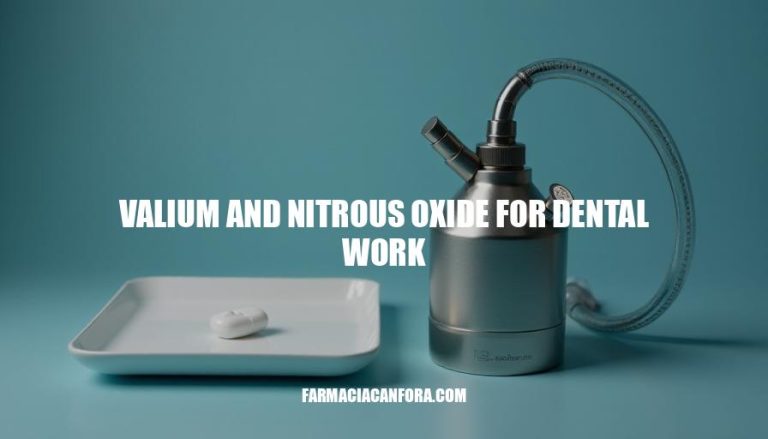


Valium helps people feel calm before going to the dentist. It’s a medicine that works by soothing the nervous system, making it easier for patients to relax during treatment.
Nitrous oxide is another tool used in dentistry to help people feel more relaxed. When breathed in, it creates a sense of calmness and reduces anxiety.
This way, patients can stay awake but feel less stressed during procedures.
When Valium and nitrous oxide are used together, they work really well to reduce dental anxiety. This combination helps patients feel more comfortable and allows dentists to do their job with greater precision, making the whole experience smoother for everyone involved.
Valium (diazepam) and nitrous oxide are commonly used sedatives in dental procedures to manage anxiety and pain. Each has distinct mechanisms of action and administration protocols, and their combined use requires careful professional oversight.
Valium (Diazepam):
Function: Valium is a benzodiazepine that enhances the effect of gamma-aminobutyric acid (GABA) in the brain, producing a calming effect. It reduces anxiety, muscle tension, and seizures, making it suitable for patients with dental anxiety.
Administration: Typically administered orally in tablet form, with dosages ranging from 2 to 10 mg depending on the patient’s age, weight, and anxiety level.
It is usually taken 30-60 minutes before the procedure.
Safety Protocols: Patients must disclose their medical history, including any allergies or current medications, to avoid adverse interactions. Monitoring for side effects like drowsiness, dizziness, or respiratory depression is essential.
Nitrous Oxide:
Function: Nitrous oxide, or “laughing gas,” is an inhalational anesthetic that induces a state of relaxation and mild euphoria. It acts on the central nervous system by modulating neurotransmitter release, providing analgesia and anxiolysis.
Administration: Delivered through a nasal mask, the gas is mixed with oxygen (usually at a 70:30 ratio) and inhaled.
The effects are rapid, with onset within minutes, and the dosage is adjusted based on the patient’s response.
Safety Protocols: Continuous monitoring of oxygen saturation and vital signs is crucial. Proper ventilation in the dental operatory minimizes occupational exposure to nitrous oxide.
Synergistic Use:
When combined, Valium and nitrous oxide can enhance each other’s sedative effects, providing deeper relaxation and pain management. This synergy allows for lower doses of each agent, reducing the risk of side effects.
Administration: Valium is administered first to alleviate anxiety, followed by nitrous oxide during the procedure.
The dentist adjusts the nitrous oxide concentration based on the patient’s sedation level.
Safety Protocols: Professional supervision is critical to prevent over-sedation or respiratory depression. Emergency equipment, such as oxygen and resuscitation devices, must be readily available.
Importance of Professional Supervision:
The use of these sedatives requires a thorough pre-procedure assessment, including medical history and informed consent.
Only trained dental professionals should administer and monitor these agents to ensure patient safety and compliance with regulatory guidelines.
This combination, when used responsibly, can significantly improve patient comfort and procedural outcomes.
The combination of Valium (diazepam) and nitrous oxide is a highly effective way to alleviate dental anxiety and enhance patient comfort during procedures. By working together, these two agents provide a synergistic effect that reduces anxiety, promotes relaxation, and makes the entire experience smoother for both patients and dentists.
Valium helps to calm the nervous system, making it easier for patients to relax and feel more at ease before treatment. Nitrous oxide, on the other hand, creates a sense of calmness and reduces anxiety when breathed in. When used together, they can provide deeper relaxation and pain management, allowing for lower doses of each agent and reducing the risk of side effects.
It’s essential to note that the use of these sedatives requires careful professional supervision, including a thorough pre-procedure assessment, informed consent, and monitoring by trained dental professionals. Consulting with a qualified dentist is crucial for determining the best personalized sedation options for each patient.
By combining Valium and nitrous oxide responsibly, dentists can provide patients with a more comfortable and anxiety-free experience, ultimately leading to better outcomes and increased patient satisfaction.